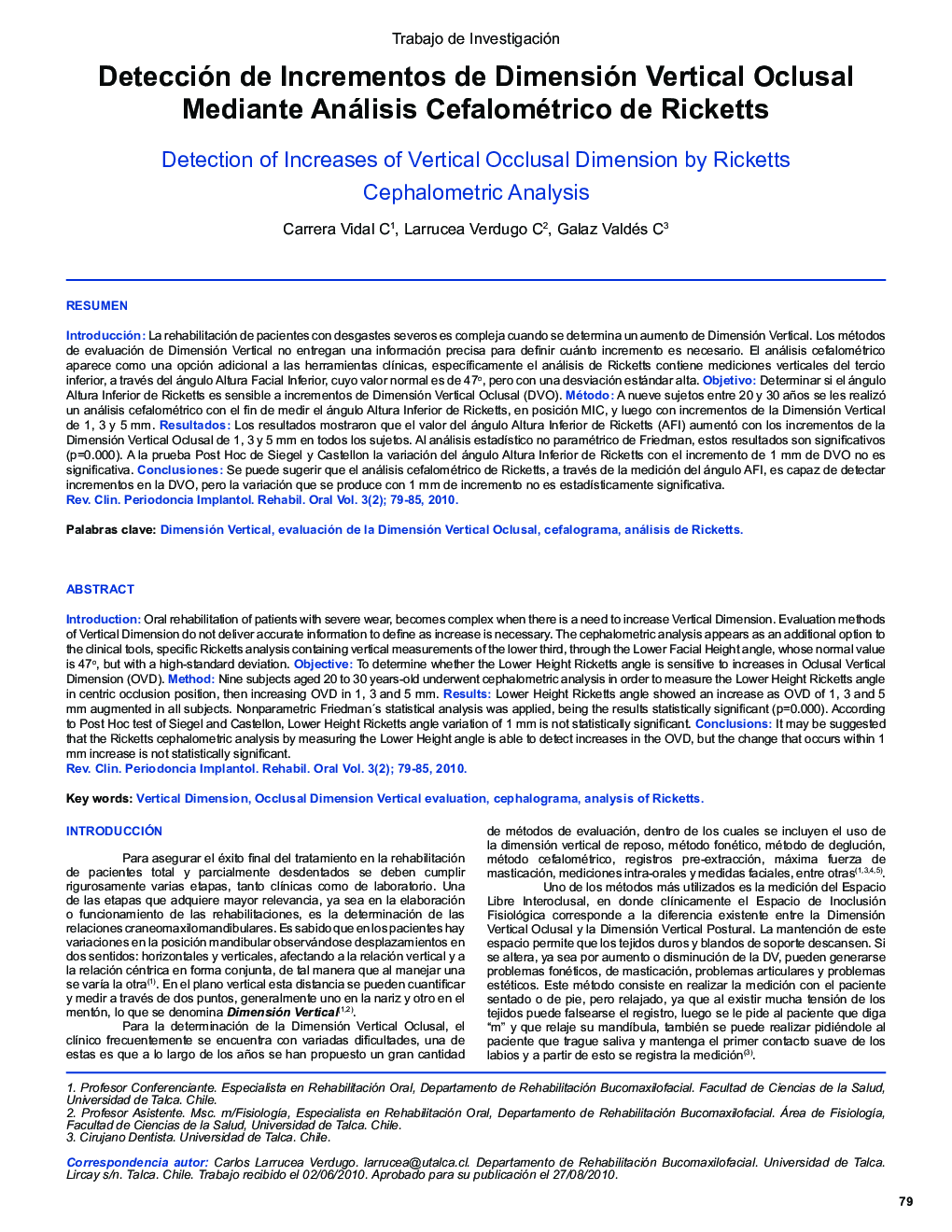| Article ID | Journal | Published Year | Pages | File Type |
|---|---|---|---|---|
| 3172475 | Revista Clínica de Periodoncia, Implantología y Rehabilitación Oral | 2010 | 7 Pages |
ResumenIntroducciónLa rehabilitación de pacientes con desgastes severos es compleja cuando se determina un aumento de Dimensión Vertical. Los métodos de evaluación de Dimensión Vertical no entregan una información precisa para definir cuánto incremento es necesario. El análisis cefalométrico aparece como una opción adicional a las herramientas clínicas, específicamente el análisis de Ricketts contiene mediciones verticales del tercio inferior, a través del ángulo Altura Facial Inferior, cuyo valor normal es de 47°, pero con una desviación estándar alta.ObjetivoDeterminar si el ángulo Altura Inferior de Ricketts es sensible a incrementos de Dimensión Vertical Oclusal (DVO).MétodoA nueve sujetos entre 20 y 30 años se les realizó un análisis cefalométrico con el fin de medir el ángulo Altura Inferior de Ricketts, en posición MIC, y luego con incrementos de la Dimensión Vertical de 1, 3 y 5 mm.ResultadosLos resultados mostraron que el valor del ángulo Altura Inferior de Ricketts (AFI) aumentó con los incrementos de la Dimensión Vertical Oclusal de 1, 3 y 5 mm en todos los sujetos. Al análisis estadístico no paramétrico de Friedman, estos resultados son significativos (p=0.000). A la prueba Post Hoc de Siegel y Castellon la variación del ángulo Altura Inferior de Ricketts con el incremento de 1 mm de DVO no es significativa.ConclusionesSe puede sugerir que el análisis cefalométrico de Ricketts, a través de la medición del ángulo AFI, es capaz de detectar incrementos en la DVO, pero la variación que se produce con 1 mm de incremento no es estadísticamente significativa.
IntroductionOral rehabilitation of patients with severe wear, becomes complex when there is a need to increase Vertical Dimension. Evaluation methods of Vertical Dimension do not deliver accurate information to define as increase is necessary. The cephalometric analysis appears as an additional option to the clinical tools, specific Ricketts analysis containing vertical measurements of the lower third, through the Lower Facial Height angle, whose normal value is 47°, but with a high-standard deviation.ObjectiveTo determine whether the Lower Height Ricketts angle is sensitive to increases in Oclusal Vertical Dimension (OVD).MethodNine subjects aged 20 to 30 years-old underwent cephalometric analysis in order to measure the Lower Height Ricketts angle in centric occlusion position, then increasing OVD in 1, 3 and 5 mm.ResultsLower Height Ricketts angle showed an increase as OVD of 1, 3 and 5 mm augmented in all subjects. Nonparametric Friedman's statistical analysis was applied, being the results statistically significant (p=0.000). According to Post Hoc test of Siegel and Castellon, Lower Height Ricketts angle variation of 1 mm is not statistically significant.ConclusionsIt may be suggested that the Ricketts cephalometric analysis by measuring the Lower Height angle is able to detect increases in the OVD, but the change that occurs within 1 mm increase is not statistically significant.
